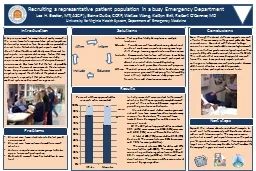PPT-Recruiting a representative patient population in a busy Emergency Department
Author : tawny-fly | Published Date : 2018-11-02
Lea H Becker MTASCP Elaine Dube CCRP Weitao Wang Kaitlyn Brill Robert OConnor MD University for Virginia Health System Department of Emergency Medicine Introduction
Presentation Embed Code
Download Presentation
Download Presentation The PPT/PDF document "Recruiting a representative patient popu..." is the property of its rightful owner. Permission is granted to download and print the materials on this website for personal, non-commercial use only, and to display it on your personal computer provided you do not modify the materials and that you retain all copyright notices contained in the materials. By downloading content from our website, you accept the terms of this agreement.
Recruiting a representative patient population in a busy Emergency Department: Transcript
Download Rules Of Document
"Recruiting a representative patient population in a busy Emergency Department"The content belongs to its owner. You may download and print it for personal use, without modification, and keep all copyright notices. By downloading, you agree to these terms.
Related Documents














